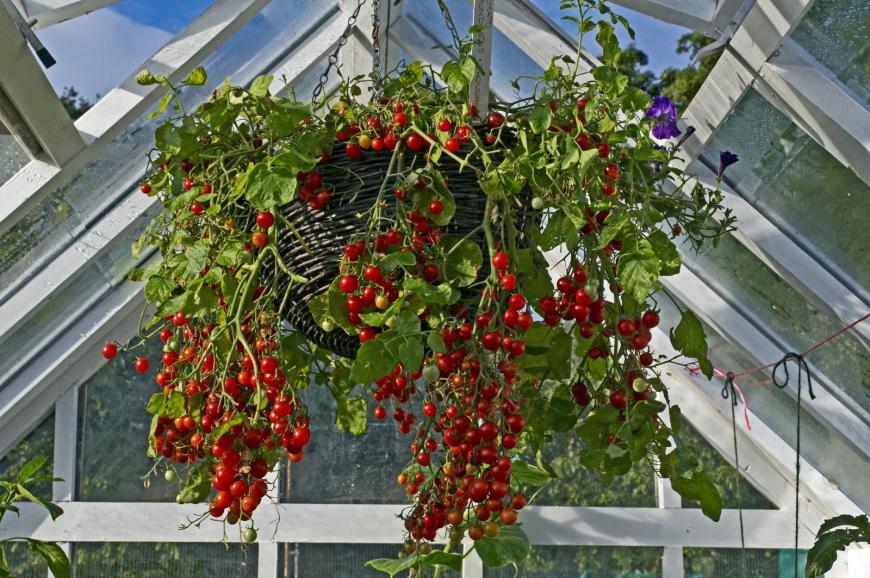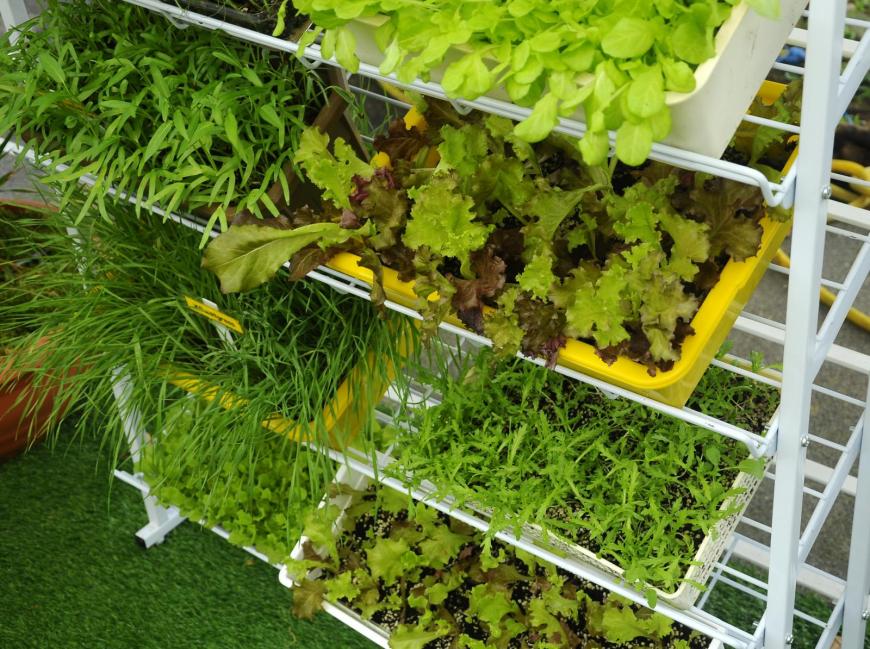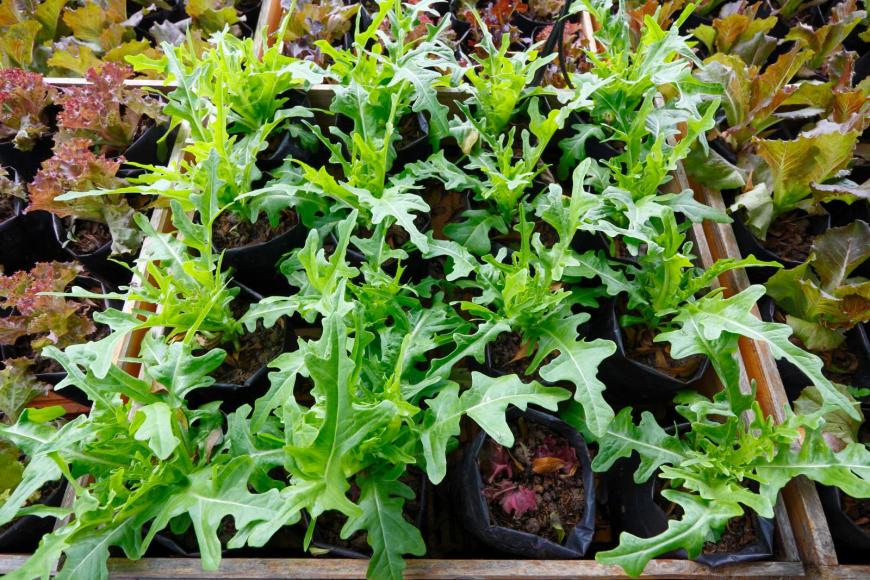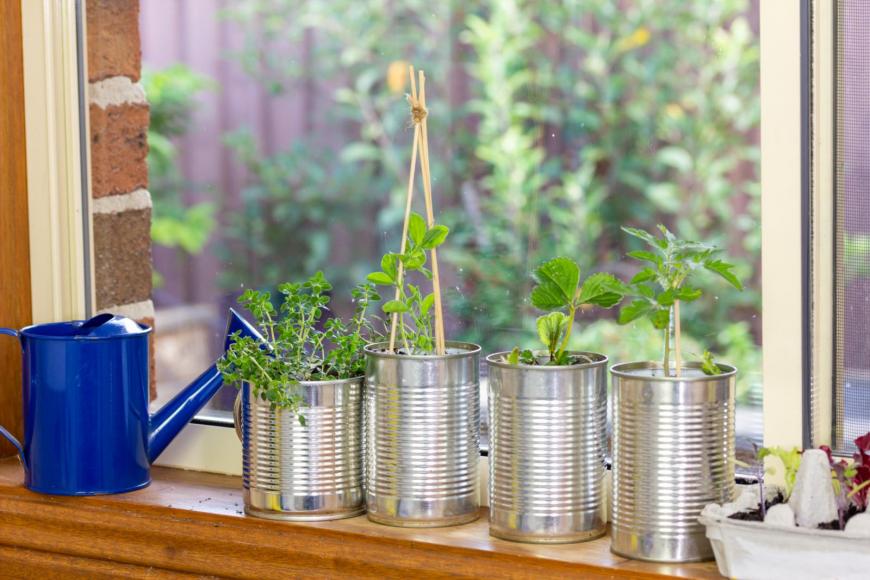
This week is National Gardening Week, a week to celebrate the nation's love of gardening and raise awareness about the positive impact that gardening has on people’s lives. But what if you don’t have a garden? What if your outside space is a patio or a balcony, or what if you don’t have any outdoor space at all? The good news is that with a little bit of gardening know-how it's perfectly possible to create a beautiful, productive, plant-filled oasis even when you have limited or no outdoor space.
In this first article on the topic of container gardening, we’ll focus on growing your own food. There is an abundance of edible plants that you can grow in containers, whether that’s on a patio, balcony or a sunny window sill. Growing in containers is great fun, and even if you do have access to a garden, container-growing is a quick way of getting edible plants on the go without needing to do any lengthy ground preparation work first. It’s also a wonderful, hands-on-learning activity to do together with children.
You can use all sorts of containers for growing edible plants in. A bucket with holes in the bottom, an old tin bath, a wooden crate, all of these can be refashioned into planters. Or if you fancy a bit of DIY, you can make your own planter out of some reclaimed wood. There are also a variety of grow bags available to buy online.

Root vegetables like carrots and beetroot will need nice deep containers, at least 30cm deep with plenty of compost. Potatoes also need large containers, 40cm by 40cm is a good size. An old plastic trug with some holes in the bottom is perfect. You’ll also need big pots for spreading, vigorous plants like mint and top-heavy plants like tomatoes and cucumbers.
For smaller containers, you can repurpose all sorts of things like baked bean cans, old metal tea caddies and old watering cans. Have a look on Pinterest for some inspiration and choose something that will make you smile. You can repurpose favourite mugs and bowls when they get broken, giving them a new lease of life as herb planters for your kitchen window sill.
All containers will need good drainage, so if there aren’t any drainage holes already, you’ll need to make a few. And if you’re growing inside, you’ll need a saucer or tray under the container to collect water in. If your pot only has one central hole in the base, place some bits of broken pot or crockery into the bottom of the pot before planting to stop the compost from washing out. You can also use pot ‘feet’ or bricks to raise pots up and prevent waterlogging.
Top-Tip: Terracotta plant pots are beautiful to look at but they do absorb water which makes the compost dry out more quickly. To remedy this, you can add a liner. Although plastic liners are normally used, I recommend using an old potato sack or some jute fabric, for a plastic-free, biodegradable alternative.
And don’t forget about hanging baskets! They’re a great way to maximize growing space.

Make the most of any sunny spots on your patio or balcony as well as any bright window sills inside. One of the great things about container gardening is that (with the exception of your larger, heavier pots) containers are moveable, so you can play around and find just the perfect position for your plants. Arrange pots in a way that maximises the space you have available. Stackable pots, shelving and hanging baskets will all maximise vertical growing space. Purpose-built vertical planters are available to buy online and there are plenty of DIY options too.

Climbing plants like peas and beans and plants that need some support like cucumbers and melons can be placed next to a wall where you can either add a trellis or some strings for them to climb up. Balcony balustrades can also be used for training climbers up. If you’re creating a garden on your balcony, do bear in mind the weight limit of your balcony as large containers of soil can get very heavy.
A good quality potting mixture, suited to the type of plant you are growing is key. There are several peat-free potting and multi-purpose composts available to buy or you can make your own with two parts soil and one part well-rotted compost. Fertilisers can be used to boost plant nutrition and are especially useful for the hungrier fruiting crops like tomatoes and container-grown fruit. There are plenty of organic options to choose from including seaweed extract and comfrey pellets and you can also make your own liquid fertilizer from nettle and comfrey plants.
Plants in containers will dry out far more quickly than those growing in the ground and will, therefore, need regular watering. A spell of rain might be insufficient for pots because plant leaves can act as an umbrella, sheltering the soil. Keep checking pots whatever the weather and aim to keep them moist at all times.
There is a vast array of edible plants you can choose from. In general, choose smaller, more compact varieties that will be better suited to container growing. It’s also a good idea to create mixed planters, with one main ‘focus’ plant, a “filler” plant which will cover the remaining surface of the soil and help prevent water loss, and a “cascader” that will trail over the side of the pot. For example, you can grow a tomato as the main plant, some parsley as a filler and nasturtiums to trail over the sides. This works well in hanging baskets as well as larger plant pots.
Let’s have a look at some of the best plant varieties to grow.
Cut and Come Again Salads. These are salads that can be continuously harvested every time you need a few leaves. Any loose-leaf, non-hearting lettuce varieties will work well such as lollo rossa and red and green salad bowl. My favourite leafy greens include mizuna, rocket and red giant mustard. Home-grown salad leaves are so much healthier and cheaper than those bags of mixed salads at the supermarket and you can create your own bespoke salad mix depending on the flavours that you enjoy.

Leafy Greens. Chards, kale and spinach are all suited to container growing and can be harvested a few leaves at a time as needed like the cut-and-come-again salads above, thus ensuring you’ll always have a fresh supply of leafy greens on your plate. Grow rainbow chard for a variety of brightly coloured stems.
Tomatoes. You can’t beat a home-grown tomato. Compact, bushy, heavy-fruiting varieties will make the best use of space.
Top Tip: Grow tumbling tomatoes in hanging baskets. Varieties such as Garden Pearl, Maskotka and Tumbling Tom work well. You can add some basil, or parley to the basket, and marigold and nasturtium (both edible flowers) are also good companion plants for tomatoes.
Herbs. Fresh herbs are perfect plants for a container garden and will happily grow in a sunny spot either outside or indoors on a sunny windowsill. To maximise space, try growing an assortment of herbs in a strawberry planter or make your own multi-level planter out of different sized plant pots.
Top Tip: Make a herb pyramid using three different size plant pots. Use a large pot for the bottom, filled halfway with a potting mixture and some extra grit to give good drainage. Choose a second, smaller pot to fit inside the first, leaving a band around the edge wide enough to plant herbs in and then repeat the process to add a third pot on top. This multi-tiered planter is perfect for strawberries too!
Root Crops. Beetroots, carrots and radishes can all be grown in pots. Choose a nice deep pot for carrots or try some of the shorter, stumpier varieties available such as Oxheart.
Potatoes. Potatoes are an easy crop to grow in containers and a fun activity to do with children. An old compost bag, metal dustbin or plastic trug can all be used to grow a bumper crop of home-grown spuds.
Climbing Beans and Peas. Climbing beans are a great crop for maximising vertical space and they are beautiful to look at too, with flowers that will attract bees and other pollinators. Beans and peas need to be harvested continuously to encourage further pods to form which makes them a productive crop for small spaces. Picked young and tender beans make a lovely raw addition to salads. Get creative making climbing structures. Plants can be supported with a wigwam of sticks placed in the pot or with trellises attached to a wall.
Strawberries. Great for a small space, strawberries can be grown in multi-level planters.

Fruit Trees and Bushes. Slow-growing, less vigorous varieties of fruit can be grown in large pots. Tender trees such as citrus fruits, nectarines, olives and pomegranates are ideal for container growing as they can be moved inside to a frost-free place over winter. Blueberries are very happy in containers and prefer an acid soil, so use ericaceous compost.
Other Top Picks for Container Crops: Sweet peppers, aubergines, cucumber and squash.
A sunny windowsill is the perfect growing spot for all sorts of plants. Gardening indoors means you can take advantage of the warmer temperatures of your home to extend the growing season and grow plants that would normally thrive in warmer climates. Here are some top tips for growing food on your windowsill.

Extend your space. To maximise growing space, put a table up against the window. You can also attach trellises to the side of window frames for climbing beans and suspend hanging baskets from the ceiling or the top of window frames (making sure that hooks are securely positioned as the baskets will be heavy).
Focus on crops that mature quickly and can be continuously harvested. Cut and come again salads are a great choice for window sill gardening (see above for varieties) and fresh herbs are perfect for a sunny kitchen windowsill.
Choose compact plants. Focus on varieties that suit smaller spaces, e.g. cherry tomatoes and radishes.
Grow microgreens. Bursting with flavour and nutrition, microgreens or micro leaves are the seedlings of plants that would normally be grown to full-size before harvesting. They are quick to grow, normally ready in a week to ten days, and take up very little space. Popular favourites include basil, beetroot, broccoli, coriander, fennel, mizuna, mustard, radish, rocket and spinach.
Top Tip: Grow your own salsa. Grow a pot of tomatoes, a pot of chillies and a pot of coriander, and enjoy making your own fresh, spicy salsa. Sow a pinch of coriander seeds every few weeks to keep a continuous supply going.
With a bit of planning, it’s possible to grow an abundance of food in containers. Have fun experimenting and creating your own mini food jungle, the rewards are definitely worth it!
Loading recent activity...